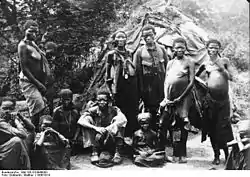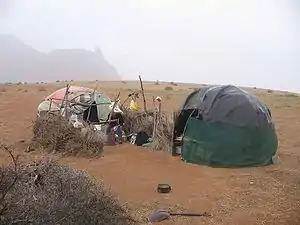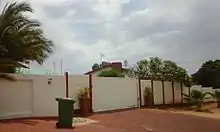Nama people
Nama (in older sources also called Namaqua) are an African ethnic group of South Africa, Namibia and Botswana. They traditionally speak the Nama language of the Khoe-Kwadi language family, although many Nama also speak Afrikaans. The Nama People (or Nama-Khoe people) are the largest group of the Khoikhoi people, most of whom have largely disappeared as a group, except for the Namas. Many of the Nama clans live in Central Namibia and the other smaller groups live in Namaqualand, which today straddles the Namibian border with South Africa.
.jpg.webp) A Nama man of Namibia. | |
| Regions with significant populations | |
|---|---|
| 130,349 | |
| Languages | |
| Nama, Afrikaans, English | |
| Religion | |
| Christianity, African Traditional Religion, Islam | |
| Related ethnic groups | |
| Khoekhoe | |
History


For thousands of years, the Khoisan peoples of South Africa and southern Namibia maintained a nomadic life, the Khoikhoi as pastoralists and the San people as hunter-gatherers. The Nama are a Khoikhoi group. The Nama originally lived around the Orange River in southern Namibia and northern South Africa. The early colonialists referred to them as Hottentots. Their alternative historical name, "Namaqua", stems from the addition of the Khoekhoe language suffix "-qua/khwa", meaning "people" (found in the names of other Southern African nations like the Griqua), to the language name.
From 1904 to 1908, the German Empire, which had colonised present-day Namibia, waged a war against the Nama and the Herero (a group of Bantu pastoralists), leading to the Herero and Namaqua genocide and a large loss of life for both the Nama and Herero populations.[1] This was motivated by the German desire to establish a prosperous colony which required displacing the indigenous people from their agricultural land.[2] Large herds of cattle were confiscated and Nama and Herero people were driven into the desert and in some cases interned in concentration camps on the coast,[3] for example at Shark Island. Additionally, the Nama and Herero were forced into slave labor to build railways and to dig for diamonds during the diamond rush.
In the 1920s diamonds were discovered at the mouth of the Orange River, and prospectors began moving there, establishing towns at Alexander Bay and Port Nolloth. This accelerated the appropriation of traditional lands that had begun early in the colonial period. Under apartheid, remaining pastoralists were encouraged to abandon their traditional lifestyle in favour of village life.
In 1991, a part of Namaqualand (home of the Nama and one of the last true wilderness areas of South Africa) was named the Richtersveld National Park. In December 2002, ancestral lands, including the park, were returned to community ownership and the governments of South Africa and Namibia began creating a trans-frontier park from the west coast of southern Africa to the desert interior, absorbing the Richtersveld National Park. Today, the Richtersveld National Park is one of the few places where the original Nama traditions survive. There, the Nama move with the seasons and speak their language. The traditional Nama dwelling – the |haru oms, or portable rush-mat covered domed hut – protects against the blistering sun, and is easy to move when grazing becomes scarce.
At the dawn of the 19th century, Oorlam people encroached into Namaqualand and Damaraland. They likewise descended from indigenous Khoikhoi but were a group with mixed ancestry including Europeans and slaves from Madagascar, India, and Indonesia.[4] After two centuries of assimilation into the Nama culture, many Oorlams today regard Khoikhoigowab (Damara/Nama) as their mother tongue, though others speak Afrikaans. The distinction between Namas and Oorlams has gradually disappeared over time to an extent where they are today regarded as one ethnic group, despite their different ancestries.[5]
Nama clans
- ǀKhowesen (Direct descendants of Captain Hendrik Witbooi) who was killed in the battle with Germans on 29 October 1905. The |Khowesin, reside in modern-day Gibeon under the leadership of Ismael Hendrik Witbooi the 9th Gaob (meaning captain) of the |Khowesen Gibeon, situated 72 km south of Mariental and 176 km north of Keetmanshoop just off the B1, was originally known by the name Khaxa-tsûs. It received its name from Kido Witbooi first Kaptein of the ǀKhowesin.
- Khaiǁkhaun (Red Nation) at Hoachanas, the main group and the oldest Nama clan in Namibia[6]
- ǃGamiǂnun (Bondelswarts) at Warmbad
- ǂAonin (Southern Topnaars) at Rooibank
- ǃGomen (Northern Topnaars) at Sesfontein
- ǃKharakhoen (Fransman Nama) at Gochas. After being defeated by Imperial Germany's Schutztruppe in the Battle of Swartfontein on 15 January 1905, this Nama group split into two. Part of the ǃKharakhoen fled to Lokgwabe, Botswana, and stayed there permanently,[7] the part that remained on South West African soil relocated their tribal centre to Amper-Bo. In 2016 David Hanse was inaugurated as chief of the clan.[8]
- ǁHawoben (Veldschoendragers) at Koës
- !Aman at Bethanie which was led by Cornelius Frederick
- ǁOgain (Groot Doden) at Schlip
- ǁKhauǀgoan (Swartbooi Nama) at Rehoboth, later at Salem, Ameib, and Franzfontein
- The Kharoǃoan (Keetmanshoop Nama) under the leadership of Hendrik Tseib[9] split from the Red Nation in February 1850 and settled at Keetmanshoop.[6]
Culture

In general the Nama practice a policy of communal land ownership. Music, poetry and story telling are very important in Nama culture and many stories have been passed down orally through the generations.
The Nama have a culture that is rich in the musical and literary abilities of its people. Traditional music, folk tales, proverbs, and praise poetry have been handed down for generations and form the base for much of their culture. They are known for crafts which include leatherwork, skin karosses and mats, musical instruments (such as reed flutes), jewellery, clay pots, and tortoiseshell powder containers.
Many of the Nama people in South Namibia have lost their lands during German colonialism. New Namibian minister of land reform, Uutoni Nujoma has been accused of preferring other Namibians from other regions over native Namas.[10]
Dress
The traditional dress of Nama women consists of long, formal dresses that resemble Victorian traditional fashion. The long, flowing dresses were developed from the style of the missionaries in the 1800s, and this traditional clothing is today an integral part of the Nama nation's culture.
Settlements
Traditionally, Nama camps had 5-30 huts. These huts were circular domes and their doors faced the center of camp. They were also arranged hierarchically, the chief was placed west and faced east. Other families were placed based on their seniority, Elder brothers and their families were on the far right, while younger brothers and their families on the left.[11]There are no enclosures for adult livestock. They are expected to sleep in front of their owners huts. Calves and lambs are placed in an enclosed area in the middle of camp. The huts were lined with reed mats made by women.[12]The mats are placed on wooden frames. The reeds are able to soak and absorb water well, thus being able to protect the Nama people from summer rains. These Huts are very mobile, but also stable, being able to break them down in less than an hour. The huts are also reusable.
Religion
They have largely abandoned their traditional religion through the sustained efforts of Christian (and now Muslim) proselytisers. The majority of the Nama people in Namibia today are therefore Christian while Nama Muslims make up a large percentage of the Namibia's Muslims.[13]
Burials
In the past funerals weren't a big social gathering. The Nama people simply buried the body and never spoke about the person again due to fear of spirits. today funerals are social solidarity. The position of the person in the community being buried matters that determines the burial site. Members of close relatives of the deceased person spend a week preparing the grave site, digging, and using flattened oil drums as sheets.The actual mourning takes place three days before the actual burial. During the first two night of the mourning, there is singing of hymns, preaching, and praying. On the last day of the mourning and the day of the burial, there are speeches presented and messages of condolences. [14]The grave site itself is lined with brick and once the body is inside a wooden board is laid upon the top before it is covered with dirt. This style of the burial site makes it easy for preservation of the body.
Wedding ritual

Namas have a complicated wedding ritual. First the man has to discuss his intentions with his family. If they agree they will advise him of the customs to ask the bride's family and then accompany him to the place she lives. The yard at the bride's living place is prepared prior to the future husband's family's arrival, animal hides are laid out in the corners for the different groups to sit down and discuss.[15]
The groom's family ask for the gate to be opened. If this is granted, the groom is interrogated about details of the bride, including the circumstances of their first meeting and how to identify her body marks to make sure both know each other well. If the bride is pregnant or already has children from her future husband or someone else, the bride is subjected to the "door cleansing" ceremony (slaughtering and consuming a snow-white goat). After several days the wedding ritual continues in reverse; the bride's family visits the clan of the groom. If all is to the satisfaction of the two clans, an engagement day is announced.[15]
At the engagement, the groom's family brings live animals to the woman's family home. The animals are slaughtered, hung on three sticks, and each part is offered to the bride's family. Other items like bags of sugar or flour are only offered in quantities of two or four to indicate that there will always be abundance of food. This process is also celebrated in reverse at the man's family home. White flags are mounted on both families' houses which may not be taken off but wither or are blown off by the wind one day.[15]
The wedding preparations can take up to one year. The family of the groom makes a gift to the bride's mother, traditionally a cow and a calf, for she has raised the bride at her breast. A bargaining process accompanies the gift that can take weeks in itself. On wedding day, both families provide animals and other food and bring it to the bride's home. The wedding itself takes place in a church. Festivities afterward go on for several days. The first night after the wedding the couple spends separately. On the next morning, they set off for their own home.[15]
See also
References
- "The Herero genocide: German unity, settlers, soldiers, and ideas" (PDF). Retrieved 17 January 2014. "When the war finally ended in 1908 no less than 80% of the Herero had lost their lives. The majority of the Herero who remained in Namibia, primarily women and children, survived in concentration camps as forced labourers employed on state, military and civilian projects (Pool 1979; Nuhn 1989; Bley 1971:142–169; Drechsler 1966:132-167; Gewald 1999:141-230).
- "German Imperalism | Boundless World History". courses.lumenlearning.com. Retrieved 30 May 2020.
- "Mapping the Herero and Nama Genocide". ArcGIS StoryMaps. Retrieved 30 May 2020.
- "Slavery in the Cape". Institute for the Study of Slavery and its Legacy – South Africa. Archived from the original on 10 June 2010. Retrieved 8 July 2010.
- Malan, Johan S (1998). Die Völker Namibias [The Tribes of Namibia] (in German). Windhoek, Göttingen: Klaus Hess. pp. 120–125.
- Dierks, Klaus (3 December 2004). "The historical role of the Nama nation". Die Republikein. Retrieved 8 July 2011.
- Goeieman, Fred (30 November 2011). "Bridging a hundred year-old separation". Namibian Sun. Archived from the original on 29 October 2013.
- Cloete, Luqman (2 February 2016). "ǃKhara-Khoen Nama sub-clan installs leader". The Namibian.
- von Schmettau, Konny (28 February 2013). "Aus "ǂNuǂgoaes" wird Keetmanshoop" ["ǂNuǂgoaes" becomes Keetmanshoop]. Allgemeine Zeitung (in German). Tourismus Namibia monthly supplement. p. 10.
- "Swartbooi resigned, not fired".
- Barnard, Alan (1992). Hunters and Herders of Southern Africa. Great Britain: Cambridge University. pp. 177–189. ISBN 0521411882.
- "The |Haru Oms in the Richtersveld". southafrica.co.za. Retrieved 29 October 2020.
- "Islam in Namibia, making an impact". Islamonline.net.
- Widloka, Thomas (1998). "Unearthing Culture: Khoisan Funerals and Social Change". Anthropos: 115–126.
- Sasman, Catherine (3 December 2010). "Love, traditionally – a ǀHaiǀKhaua wedding". New Era.
Literature
- Hoernlé‚ A. W. (1925) "The Social Organisation of the Nama Hottentots", American Anthropologist, New Series, Vol.27 No.1 pp. 1–24 JSTOR
- Hoernlé‚ A. W. (1918) "Certain Rites of Transition and the Conception of !Nau among the Hottentots", in Oric Bates (1918) Harvard African Studies II; Varia Africana II, pp. 65–82, Cambridge, Massachusetts. (Review by: Robert H. Lowie (Apr. - Jun., 1919) American Anthropologist, New Series, Vol. 21, No. 2, pp. 208–210 JSTOR)
- Schultze, Leonhard (1907) Aus Namaland und Kalahari, Gustav Fischer Verlag, Jena OCLC 470637064 (in German)
- Leonhard Schultze et al. (1970) In Namaland and the Kalahari, Human Relations Area Files, New Haven, Conn. OCLC 37146594
External links
| Wikimedia Commons has media related to Nama people. |